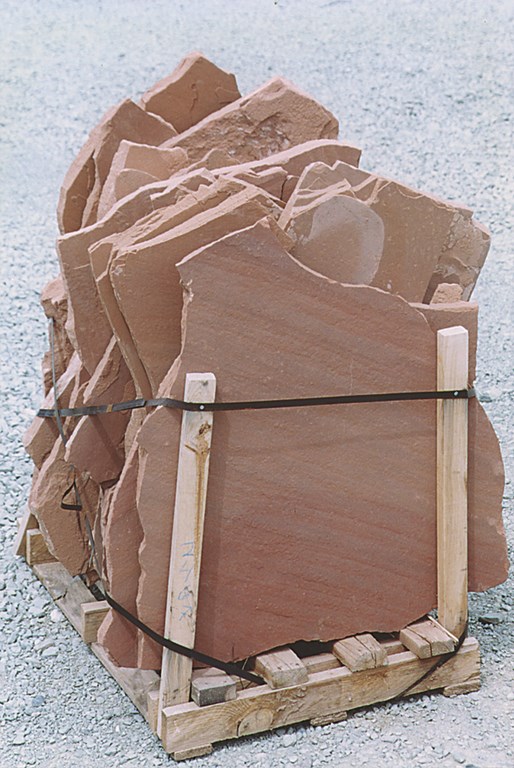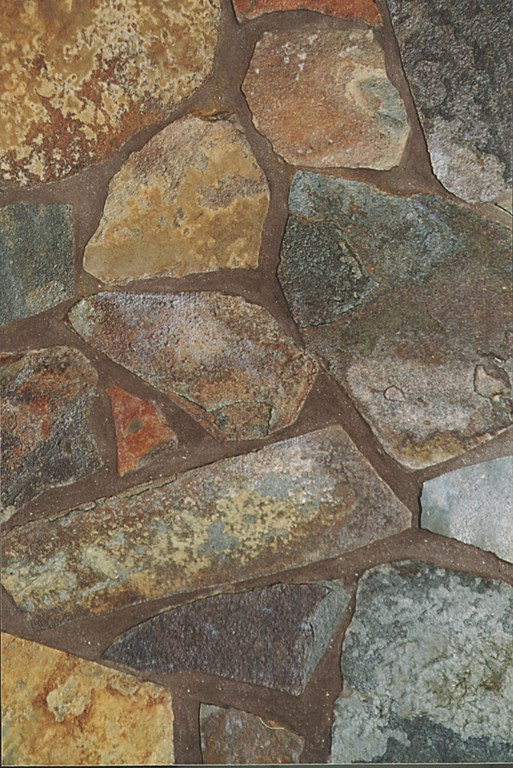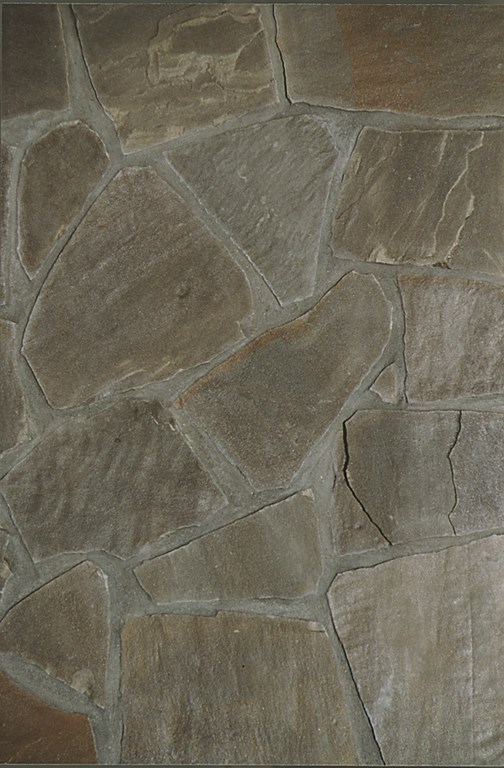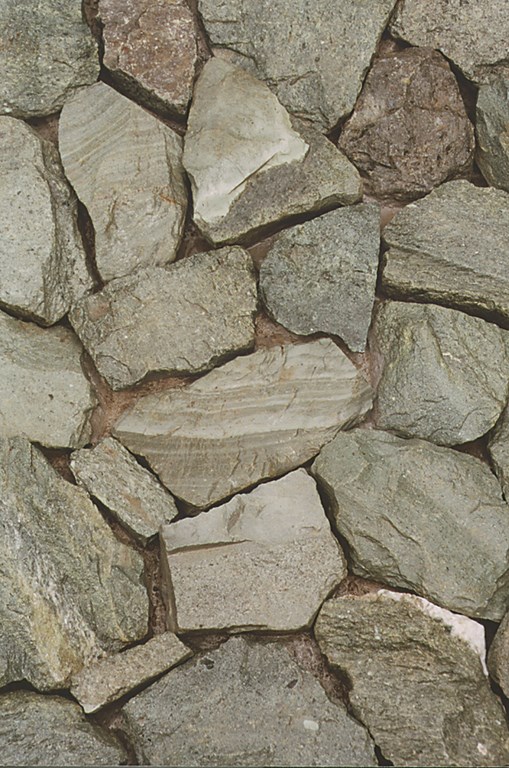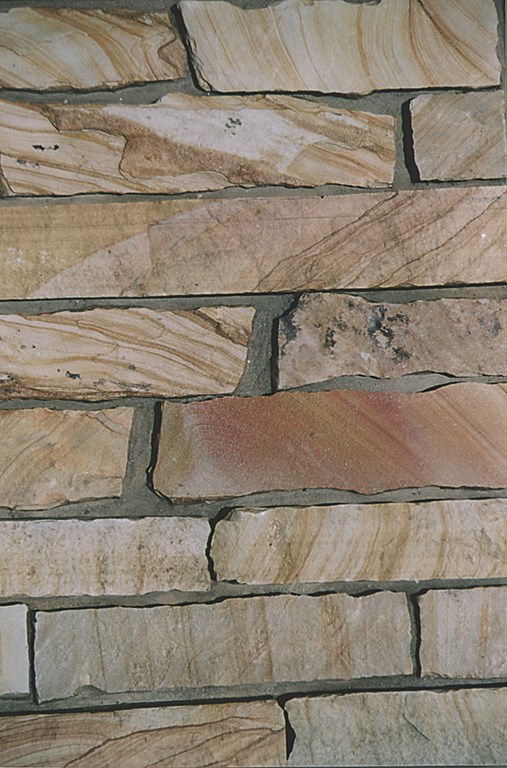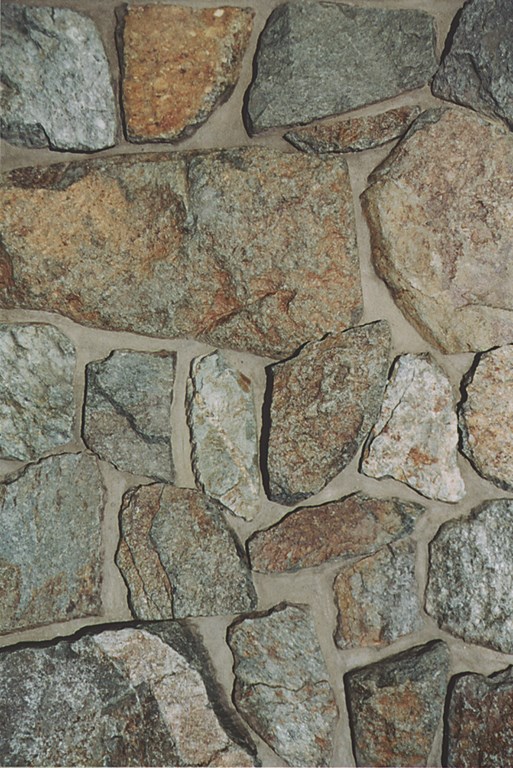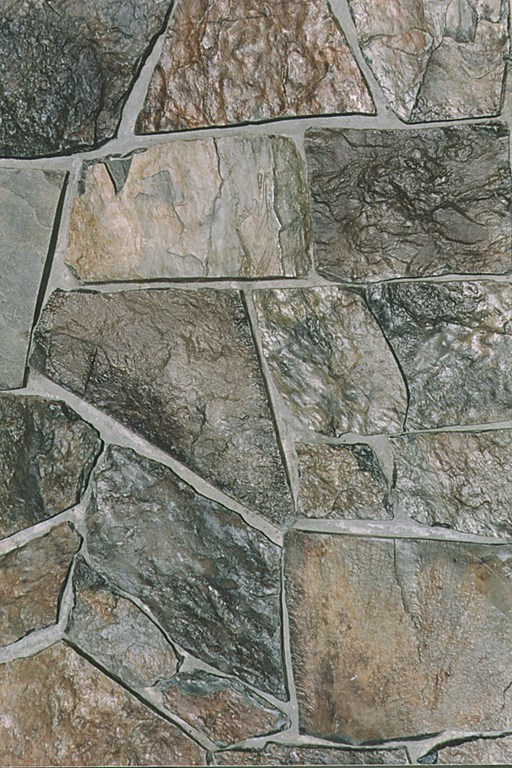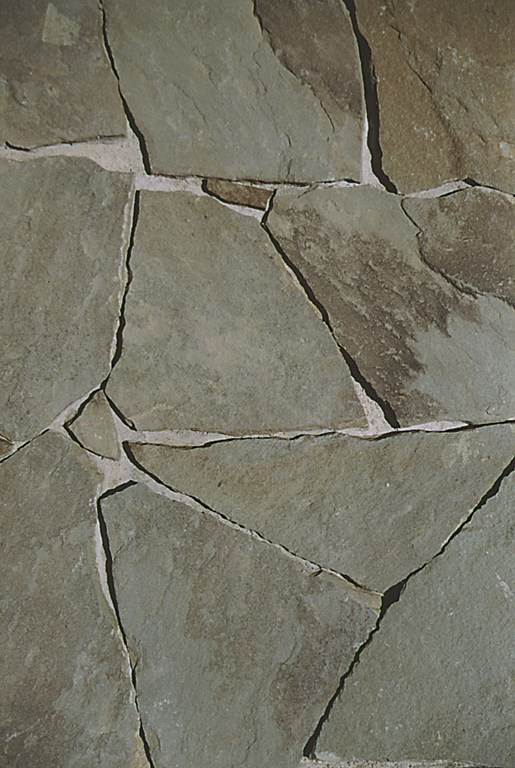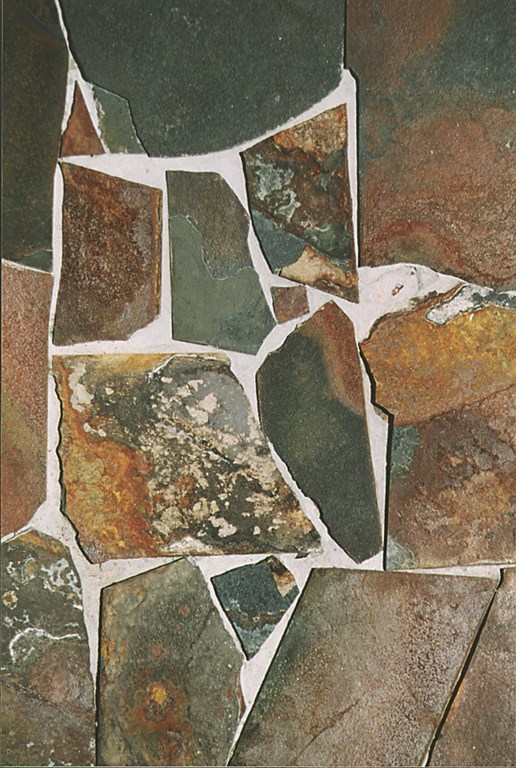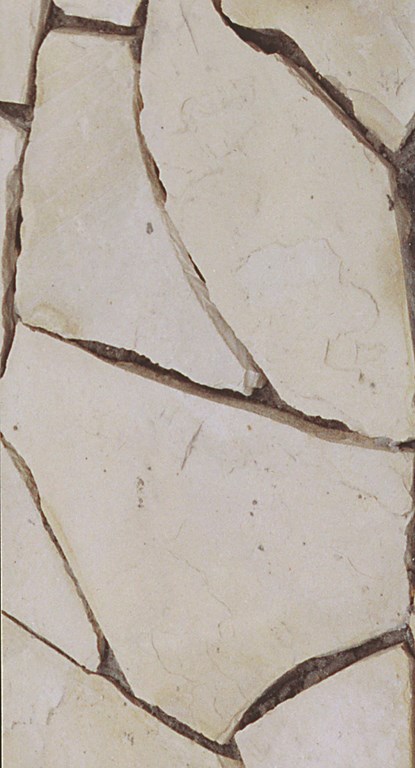Flat-Out Gorgeous
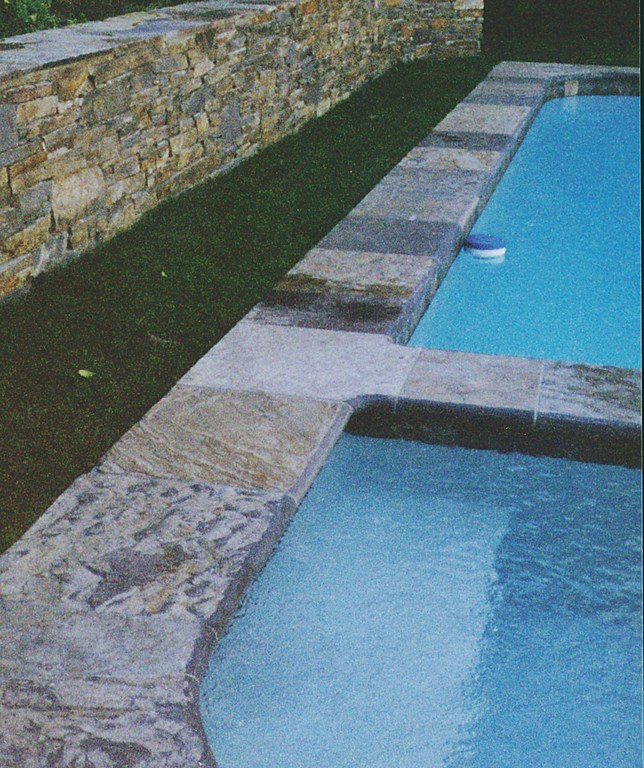
There’s never been much of a tradition in this country when it comes to beautiful stonework, especially when it comes to flat stone surfaces. What you usually see is the same few stone types used over and over again in the same sorts of applications.
To see a contrasting heritage, just travel in Europe and some parts of Asia, where you’ll see a far greater variety of flat stone used in creative ways to create pathways, walls, decks, patios and a host of architectural features, including pilasters and finials. Of course, the Old World had a long head start on us, but even so, we’ve been slow in the New World to catch up with the masonry and quarrying trades as they’ve been practiced abroad for centuries.
Fortunately, that’s starting to change. My firm, Malibu Stone & Masonry of Malibu, Calif., supplies stone (flat and otherwise) to a host of contractors, landscape architects and designers. What we’re seeing is a two-stage process: Professionals are surprised when they see the variety of stone materials available these days; they’re also pleased to learn that their clients are willing to pay more – sometimes much more – for striking or unusual stone once the full range of their options is revealed to them.
Beyond that practical component of supply and demand, architects, watershapers and other designers are also discovering the spectacular extent to which these products can blend with, highlight or enhance a particular look. This has brought on a definite trend toward pushing the design envelope.
A HIDDEN PALETTE
The key to pushing the envelope with natural, flat stone is to know what it can and cannot do and how it fits in with particular design motifs. Some of the products we sell are very dramatic in their appearance and work well when used appropriately; by the same token, they can really look out of place when misapplied. In addition, there are workmanship and maintenance issues that can lead to long-term success – or sudden failure.
That in mind, there are a few useful things to know about stone and the suppliers who make it available. First, there is no school anywhere that will teach you about the business of stone or how it is quarried, cut and delivered. It’s generally a family trade and a learn-by-doing business. To some extent, this lack of information about the stone business is part of the reason why we haven’t seen the use of stone spread to a greater extent in this country.
|
The Maintenance Factor Stone surfaces, especially stone decks or pathways, are not maintenance-free items. Failure to consider this fact all too often leads designers and contractors into the mistake of not discussing upkeep with their clients. That spells trouble because, depending on the conditions of wear to which the stone is exposed, the material can degrade and leave clients unhappy with the deck’s or pathway’s appearance. There are no “rules” here, but it’s important to be aware of wear and tear as an issue when discussing stone selection with clients. The fact is that different stone species wear better than others. The more durable stones, such as quartzite and granite, are often the best choice for high-use areas, while softer stones are perhaps better chosen for more decorative applications. Fortunately, sealers are available that can work to protect your clients’ investments, and we offer them on three levels at three price points. Our most durable sealers are designed for use with material that sees everyday traffic or comes into constant contact with water. The medium range is good for areas that receive occasional use. On the low end, we offer products that provide a protective finish for purely decorative materials. When you combine a good choice of stone with a proper sealer, your clients will most likely be pleased with the performance of the stone surface over the long haul. — J.N. |
Second, there’s basic economics. Precious metals and certain targeted resources such as coal and petroleum have been mined extensively (even to the point of depletion in some cases), but quarrying for the purpose of extracting decorative stone has not been a big business in this country by any means. Stone quarrying is a highly capital-intensive activity, but the rewards here a much less certain than they are for copper mines or coal fields.
The grand architectural traditions of European cities evolved before the Industrial Revolution, and quarrying was indeed a Big Business behind the splendor of cities from Rome or London to Paris and Vienna. In fact, the business has been so well established that it’s not unheard of even today for U.S. designers to travel abroad and ship stone materials back home at great expense to get just the look they’re after.
But as I mentioned above, this picture is definitely changing. In recent years, capital has been flowing into quarrying operations in this country, and many of those new businesses are thriving. (Interestingly, some of these businesses developed through the attrition of family farms: In fact, several quarrying operations in this country are now owned and operated by people who were once involved in agriculture.)
In states including Nevada, California, Colorado and Montana, quarrying operations have grown by several hundred percent in recent years. This increase in exploration has yielded a broad array of stone types that were not available even a few years ago. As our hot economy has fueled spending on new construction, home improvement and indoor and outdoor decoration, this increased supply and variety of natural stone has met a real demand head on.
The result has been some very distinct tendencies in the use of flat stone as a stylistic element. From where I sit, it’s been a fun and fruitful set of trends to watch.
COLORFUL CAPACITY
Color is the key to all of this growth in interest in quarried stone: The greater the range of stone types available, the greater the variety of colors that designers have at their disposal. And this is especially important in flat stone when the material is used to cover large surface areas. Here, the selection of a stone color becomes similar in nature to the selection of paint or plaster.
|
Key Characteristics When selecting stones, it’s useful to be aware of the ways in which materials differ and to ask specific questions about these characteristics: [ ] Color and color variation: If a particular type of stone you’re after has a lot of color variation, you want to be familiar with the range you’re buying. In other words, don’t base a purchase on just one or two samples if a precise coloration is what you’re after. While variable colorations can be wonderful in naturalistic settings, you’ll probably want greater consistency if you’re working with a more formal style or architecture. [ ] Strength: There’s a huge range in just how tough these materials can be. As mentioned in the accompanying feature and in the sidebar above, selection depends on intended use: If the stone will be placed in a high-traffic area, it makes sense to select materials (and sealers) that are strong enough to take it. If the application is purely decorative, however, softer materials may do just fine. [ ] Texture: This is an issue that is not often considered in much detail, but it can be critical depending on the application. Natural stones offer a variety of textures from smooth to rough and soft to hard. If the stone is to be used in a seating area or in a place where people will be barefoot (such as near a pool or spa or in a children’s play area), the way the material feels to the touch may be extremely important. [ ] Workability: As quarrying operations have proliferated around the country, we’ve seen an increase in the variety of ways in which stones are cut. It’s a great savings when you can use the stone right off the pallet, but in many cases, designs call for cutting the stone to fit specific patterns or visual textures. This cutting can be surprisingly costly, so it pays to take the hardness and general workability of the material into account. [ ] Adhesion: Some stones just won’t stick to certain types of bonding materials. That’s not really a problem so long as you know what you’re working with and plan on using an appropriate admixture in your mortar beds and grouts. The key here is to ask questions and know the characteristics of the material you’ve selected. After all, nobody want to see chunks of stone falling off of vertical surfaces or coming loose on steps. [ ] Size and scale: Quarrying techniques are the key here: Some cut stone materials with consistent size, while others let size vary greatly – and you need to know which way your quarry of choice works. Size distribution can be a critical design and construction issue. If your design accommodates a variety of sizes, materials that come in a range will fill the bill. But if you’re after uniformity, you may wind up with a lot of waste in a material that varies tremendously in size. [ ] Cost: In our business, we sell product that range from a dollar per square foot up to $20 per square. Contractors and designers know the ropes in terms of cost and budget, but what we’ve found consistently is that when clients are cued into the beauty of the stone materials available to them, they are often willing to devote more money to purchasing a material they truly love. — J.N. |
Our firm sells to professionals all over the country, with the result that we’ve been able to watch certain trends emerge in very specific regions. In the eastern United States, for example, designers have leaned toward dark gray, green and blue stones to support Victorian, Tudor and Cape Cod architecture. Across the country in California, by contrast, stone is often used as a transition material between inside and outside areas, and this has led to a strong trend toward what are known as Hacienda colors – tans, sands, caramels and light browns.
We’ve also seen some trends quickly run their courses. We’ve noticed, for example, a definite drop in the demand for pinks and pastel colors, a sure sign that an early-90s indulgence in Mediterranean design has run its course. And we’ve witnessed micro-trends, such as upwellings of interest in certain areas in Moroccan or Islamic styles.
More than anything, today’s market is one of expansion and experimentation without any specific style or trend in mind. We’re seeing a great many designers who are blending stones to create whole new looks or who are combining flat stones with ledgers for architectural elements such as walls and columns. We also see lots of use of dramatically colored stones to create strong accents in fields of subtly colored stones.
These explorations into new looks often yield tremendous results, especially when design fundamentals such as balance and color theory are properly applied.
This free-wheeling experimentation has also led to some bold failures. The hard reality is that many of these stone types are difficult, either with respect to being cut to shape or because of differences in their adhesion qualities. This points up the fact that the designer and installer need to know what they’re getting into and must select stones that can be worked according to plan along with the right setting materials and sealants (see the first sidebar above for details).
In addition, there are differences in the way stones can and should be used that come into play. Some are well suited to high-use, high-traffic areas; others will break down in rapid order. Likewise, some stones can be used underwater; others should never be submerged – particularly not into chemically treated pool or spa water.
In other words, while natural stone materials are beautiful and exciting, you must do your homework and learn about the technical realities of the specific materials you propose to use. Otherwise, you could be cutting into a mountain of trouble.
MATERIAL FACTS
There’s the rub: All of these discussions of color, style, workability and durability boil down to the specific stones you want to use.
It would be impossible here to offer a detailed catalogue of available stone types and their characteristics, but allow me to walk through a sampling – some popular, some unusual – with an eye toward understanding the key characteristics of each. In this way, I hope to arm each of you with enough information to begin asking the right questions of your stone suppliers.
Arizona Flagstone
This is a fairly broad category of common stone materials found and used quite often in California and the Southwest. The colors range from tans to reds and tend to vary according to the region from which they were quarried. At our firm, for instance, we sell varieties with names such as Arizona buckskin, buff, cinnamon, oak, rose and Sedona red.
Very soft and easy to quarry, Arizona flagstones are sedimentary rocks that are both abundant and among the most affordable stone materials available. They fit well within a broad range of styles that call for subtle colors and soft textures, including Hacienda, Mediterranean and Spanish Colonial. They also look good with woods and soft plasters. This stone contains a lot of silica and gypsum, however, so it is not good for use underwater.
Canadian Chocolate Flagstone
Here’s where stone names can be deceiving. One might assume that this stone is similar in nature to Arizona flagstones, the difference being that it comes from a different place. Nothing could be further from the truth: This stone is actually a slate material, which gives you a whole different look with bold reds and rusts, contrasted by deep grays and gray/blues.
This isn’t a stone you see everywhere. It is extremely hard and can be used to create very precise cuts, which has made it a material of choice for bold accents in crisp architectural designs. There’s also a great deal of variation in this stone, so careful selection can yield some interesting individual pieces and truly unusual or outstanding highlights.
Caribbean Blue/Gray Flagstone
Here’s yet another completely different look found in the broad grouping of “flagstones,” a word that has to do with how the stone is cut at the quarry rather than the stone’s physical nature. This one, for instance, is a quartiletic stone, which means it’s a mixture of quartz and sand.
Found in many of the older quarries in the eastern United States, this stone is very hard and is consistent in color and texture. It lends itself well to a couple of specific looks, working well in Cape Cod and English Cottage motifs. It’s very flat and dark – and tends to become extremely hot when the sun pounds on it in summer.
Catalina Cove Fieldstone
This material is from a class known as granite schift. Very hard with a consistently gray coloration, this material comes more in boulder form rather than flat stock. But because the material is so hard, it can be broken along very distinct facets and flat surfaces, which makes it a wonderful choice for walls and walkways.
Cheyenne Autumn Flagstone and Ledger
To me, this is a truly beautiful stone material – a metamorphic quartz stone that comes from the upper Midwest, Wyoming, Montana and the Upper Rockies. It offers a wide range of color variation within a rich range of golds, creams, sands and caramels.
This is an expensive stone (depending on supply), but it’s a favorite for architects and designers who are looking for beautiful accents in this color palette. And because this stone comes in both flag and ledger forms, it works equally well for flat surfaces or for elevation transitions on steps and walls.
Idaho and Nevada Quartzites
There’s a saying in the stone business that if you’re looking for a quarry, you’ll find it at the end of the road. That’s particularly true if you seek specimens from this family of remarkable stone materials, which is found in some of the most remote regions of our country.
Quartzites are metamorphic rocks that are very hard and durable and difficult to cut. They feature particles of quartz blended in varying patterns with a variety of silica and other mineral constituents. The result is a range of bold colors leaning toward the cool side of the palette along with shades of green and soft gold – all with an internal luminescence. The stone literally twinkles in sunlight or when showcased in landscape lighting and is truly glorious when wet.
It’s tough to peg this stone to a specific style, other than to say it’s bold and even ostentatious. It’s not for every taste, but those who love quartzite really love it.
Kennesaw Mountain Moss Veneer and Ledger
This is a dark granite material from the Ozark region. Very hard and smooth and offering a rich range of deep greens and grays, much of this stone is found on the surface and, as the name implies, it’s often covered with a patina of moss and lichen. This is a fairly “new” stone and has only become available in recent years.
New York Bluestone
This extremely popular quartiletic sandstone is very hard and comes in distinctive grays that are especially beautiful when used alongside the white plaster and trim of the Cape Cod or Victorian styles.
Wyoming Valley Flagstone and Ledger
This metamorphic stone is extremely high in iron content, which lends it deep, distinctive red, brown and rust color variations. This is one of those stones that is not terribly versatile in terms of appearance, but designers we know have used it on projects as diverse as mountain cabins and Moroccan-style homes.
Prima Crema
One of my favorites, this is a brilliant cream and straw-colored limestone, very soft and very expensive. I’ve seen this material used to great effect in a variety of settings and styles – and it goes really well with greens, which makes it a natural companion to landscaping.
GO LOOKING
The list above ran on a bit longer than I initially thought it would; even so, it only scratches the surface. Although you’ll find variations in available supplies from region to region, chances are better than good that the selection of flat, decorative stones available to you wherever you are is far better and broader today than it has ever been.
|
Wet and Dry One of the most important issues for watershapers with respect to flat, natural stone material is whether or not that material will hold up when permanently submerged in water. Fortunately, there are some clear guidelines to follow: [ ] Wet Use: Granites, schifts and quartzite stones are good for use in water. Their looks will change when wet, but they won’t deteriorate as a result of prolonged exposure to water treated within normal water-chemistry parameters. [ ] Dry Use: Steer clear of materials from the sandstone or limestone families in water. These contain relatively soluble minerals and will not last when submerged.— J.N. |
So get out and explore local stone and masonry supply yards. Ask questions about the varieties they stock – and always, always look for vendors who can offer support about critical workmanship and maintenance issues. In addition, you should think about stretching your reach beyond convenient local suppliers, because what you can obtain out there might represent a mind-boggling expansion of your stone palette.
Odds are, the time you spend surveying your options on this front will be well spent as the aesthetic possibilities available to you expand – and as your clients’ expectations about what you can deliver expands right along with your design options, inspiration and creativity.
Joe Nolan is vice president and co-founder of Malibu Stone & Masonry Supply in Malibu, Calif., a construction wholesaler specializing in decorative stone products. Following several years as a construction superintendent for a general contractor, Nolan began his career in the stone business in 1985 when he went to work in sales for a masonry retail and wholesale supplier. Recognizing a large void in the decorative stone supply business, Nolan and co-founder Scott Armstrong established Malibu Stone & Masonry Supply in 1997.











